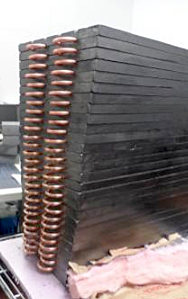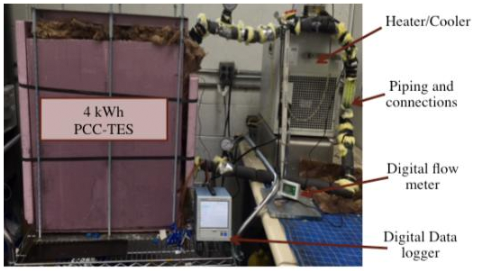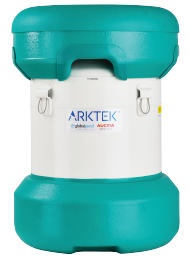 The Phase Change Matters e-mail newsletter is a weekly summary of the latest news and research on phase change materials and thermal energy storage. To subscribe, visit www.puretemp.com/subscribe. For more frequent updates, follow @puretemp on Twitter or visit the Phase Change Matters blog, www.puretemp.com/pcmatters.
The Phase Change Matters e-mail newsletter is a weekly summary of the latest news and research on phase change materials and thermal energy storage. To subscribe, visit www.puretemp.com/subscribe. For more frequent updates, follow @puretemp on Twitter or visit the Phase Change Matters blog, www.puretemp.com/pcmatters.
HVAC
Phase change composite shows potential to double AC compressor efficiency
Using a phase change composite material, researchers at the University of Illinois at Chicago have developed a novel thermal energy storage system that has the potential to downsize conventional air-conditioner compressors by 50 percent and double compressor efficiency during off- and mid-peak hours.
The research is described in a paper titled “Design and optimization of a hybrid air conditioning system with thermal energy storage using phase change composite,” recently accepted for publication in Energy Conversion and Management. One of the authors, Said Al-Hallaj, a research professor of chemical engineering at UI-Chicago and CEO of AllCell Technologies LLC, answered a few questions by e-mail.
Q: Who led the research team, and how long did the project take?
A: “It is an ongoing project since 2015 at the University of Illinois at Chicago, where I work as a Research Professor of Chemical Engineering, and part of the PhD thesis for my graduate student Ahmed Aljehani.”
Q: Who funded the project?
A: “Ahmed has a scholarship from his government in Saudi Arabia and we get technical support from our industry partners NETenergy and AllCell Technologies LLC.”
Q: Who supplied the PCM?
A: “I believe it is n-tetradecane (C14H30) PCM that we bought from a distributor and not sure about actual source.”
 Q: What is its peak melting point?
Q: What is its peak melting point?
A: “4-6 degrees Celsius.”
Q: What is its thermal storage capacity?
A: “180 kJ/kg (78% PCM, 22% graphite).”
Q: Describe the benchtop PCC/TES system size, components and functionality.
A: “The actual 4 kWh PCC-TES structure is made of 28 slabs of PCC [right]. The whole PCC-TES structure is thermally insulated with building insulation materials. Each slab represents a graphite structure that has been soaked into n-tetradecane for at least 24 h until impregnated with n-tetradecane. The slabs are numbered from top to bottom; top being number 1. The second component is the copper tubes or the copper coils, which pass back and forth in between the 28 slabs. The copper tubes enter the PCC-TES structure from the top and exits from the bottom of the structure.”
Q: Is the concept intended mainly for commercial AC systems, or could it be adapted for residential use?
A: “It should work for both, but commercial AC applications are more economically beneficial due to rate structure and peak demand requirements.”
Q: What are the next steps in developing this concept?
A: “NETenergy, our technology commercialization partner, is partnering with National Renewable Energy Laboratory and a major OEM to build and test a full-scale prototype at NREL facilities in the next year or so.”

COMPANY NEWS
Alexium International CEO resigns
Alexium International Group Ltd. said its chief executive officer, Dirk Van Hyning, resigned this week for personal reasons. He was appointed CEO in June 2017.
Robert Brookins, Alexium’s executive vice president of research and development, has been appointed interim CEO. Alexium, based in Greer, S.C., and Perth, Australia, makes flame-retardant and PCM-enhanced fabric treatments.
In April, Alexium announced that it had developed an “innovative thermal analytical testing methodology” to measure the cooling capacity of PCM-enhanced products used on pillows, sheets and mattresses.
In an April 23 news release, the company said:
“Alexium developed a testing protocol using a standard industry tool to quantify the cooling capacity, or enthalpic cooling, of PCM products when applied to pillows and other bedding fabrics. As a result, using this testing protocol, pillows treated with Alexium’s Alexicool PCM solution were shown to deliver over 500% greater cooling capacity than commercially available pillows treated with other PCM products.
“Testing was conducted on microencapsulated octadecane-based PCM in a controlled lab environment using a differential scanning calorimetry method developed by Alexium scientists with a TA Instrument DSC 250. The method was developed to be applicable across a wide range of fiber composition, fabric construction, and types of PCM.”
Alexium said the protocol allows for “facile adoption by the industry.” But the company has not responded to questions about whether a detailed description of the protocol would be made public so that results can be replicated and a new industry standard established. It is not clear how the protocol compares to other known methods used for quantifying cooling capacity, such as ASTM Standard D7984.
PATENTS
Compositions comprising PCM and methods of making the same
U.S. patent application 20180148621 (applicant Phase Change Energy Solutions Inc., Asheboro, S.C.):
“In one aspect, compositions are described herein. In some embodiments, a composition comprises a phase change material, a hydrophobic sorption material, and a viscosity modifier. In some embodiments, a composition comprises a foam and a latent heat storage material dispersed in the foam, the latent heat storage material comprising a phase change material and a hydrophobic sorption material.”
Method for controlling the release of heat by a temperature control unit
U.S. patent application 20180147916 (applicant Thermo King Corp., Bloomington, Minn.):
“[An] HVAC circuit for a temperature control unit, the HVAC circuit comprising: a phase change material (PCM) reservoir; wherein the HVAC circuit is configured to operate in a heat storage mode, whereby heat generated by the temperature control unit for providing temperature control within the internal space is stored in the PCM reservoir, and wherein the HVAC circuit is configured to operate in a heat release mode, whereby the heat generated by the temperature control unit for providing temperature control within the internal space is released to an ambient environment outside of the internal space.”
Thermal management device using phase change material
U.S. patent application 20180149437 (applicant Boeing Co., Chicago, Ill.):
“A device manages thermal energy applied to a composite patch on a structure having a heat sink. The device includes an enclosure configured to be placed on the structure overlying the composite patch, and a phase change material within the enclosure for absorbing the thermal energy.”
IN BRIEF
 • Wired takes a close look at Arktek, “the Ebola vaccine’s high-tech thermos.” The World Health Organization is using the PCM-equipped container to transport the temperature-sensitive vaccine to wherever it’s needed, whatever the conditions. The container is designed keep payloads colder than -65 C for five days.
• Wired takes a close look at Arktek, “the Ebola vaccine’s high-tech thermos.” The World Health Organization is using the PCM-equipped container to transport the temperature-sensitive vaccine to wherever it’s needed, whatever the conditions. The container is designed keep payloads colder than -65 C for five days.
• With an eye toward increased profits, CEO Edward Breen says DowDuPont is moving away from large-scale R&D projects in favor of less risky initiatives of $30 million or less.
• Viking Cold Solutions has posted an opening for a business development manager for the Northeastern United States.
• ASHRAE has published a new standard describing a methodology to apply building energy modeling throughout the design process. ASHRAE Standard 209-2018 defines minimum requirements for providing energy design assistance using building energy simulation and analysis.
• Pelican BioThermal is opening its first Canadian drop point for the Credo on Demand rental program. The new drop point, at ATS Healthcare headquarters in Toronto, offers customers an additional location to return temperature-control pallet and bulk shippers.
RESEARCH ROUNDUP
For our full list of recent academic research, see puretemp.com/academic. Here are highlights from the past week:
From Chemical Engineering Journal:• Glycolysis of Advanced Polyurethanes Composites containing Thermoregulating Microcapsules
• Effect of the insulation level on the thermal response of a PCM-modified envelope of a dwelling in Chile.
From Electrochimica Acta:
• Development and evaluation of a new ammonia boiling based battery thermal management system
• Thermal and economic analysis of charging and discharging characteristics of composite phase change materials for cold storage
• Investigation on designed fins-enhanced phase change materials system for thermal management of a novel building integrated concentrating PV
From Journal of Molecular Liquids:
• Particle size effect on thermophysical properties of nanofluid and nanofluid based phase change materials: A review
• Optimization of finned solar photovoltaic phase change material (finned pv pcm) system
• A parametric experimental investigation of the heat transfer in a coil-in-tank latent heat energy storage system
From Energy & Fuels:
• N-alkanes phase change materials and their microencapsulation for thermal energy storage: a critical review
• Lattice Boltzmann simulation of flow and heat transfer evolution inside encapsulated phase change materials due to natural convection melting
From Reactive and Functional Polymers:
• Synthesis and characterization of poly(ethylene glycol) acrylate (PEGA) copolymers for application as polymeric phase change materials (PCMs)
From Construction and Building Materials:
• Temperature responses of asphalt mixture physical and finite element models constructed with phase change material
From Renewable and Sustainable Energy Reviews:
• A review of phase change material and performance enhancement method for latent heat storage system
NETWORKING
Connect with PCM experts and industry leaders on LinkedIn
 More than 1,250 people have joined a LinkedIn group devoted to the discussion of phase change material and thermal energy storage. The Phase Change Matters group is an interactive complement to the award-winning blog and newsletter of the same name.
More than 1,250 people have joined a LinkedIn group devoted to the discussion of phase change material and thermal energy storage. The Phase Change Matters group is an interactive complement to the award-winning blog and newsletter of the same name.
You are invited to join the group and connect with PCM and TES experts from around the world. This week we welcome Sarra Drissi, postdoctoral researcher at Hunan University of Science and Engineering, Hunan, China; Khawla Saafi of Laboratoire de Métrologie et des Systèmes Energétiques, Monastir, Tunisia; Preetam Anbukarasu, research assistant at the University of Alberta, Edmonton, Canada; Paul Dougan, CEO of I AM SOLAR International, Edinburgh, U.K.; and Josh Lister, vice president at Deutsche Bank, London.